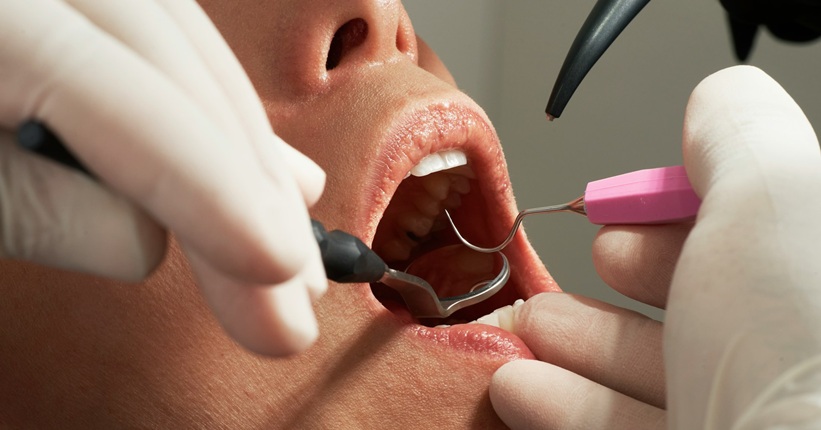
Surgical Tooth Removal — Everything You Want to Know
Surgical removal of teeth, also called surgical extraction, is one of the more advanced dental procedures that requires specialized knowledge and skills. This is the process of removing a tooth that cannot be easily removed by standard methods due to its location, damage or other complications. Most often they are used in cases of retained or severely damaged teeth. When and why is it necessary to remove teeth surgically? How is this procedure performed, what are its indications and recommendations after the procedure?
What is the surgical removal of teeth?
Surgical removal of teeth, also called surgical extraction, involves the removal of a tooth that cannot be removed in the traditional way (by simple removal). This is a more complex process that usually requires the intervention of a dental or maxillofacial surgeon.
How is tooth extraction different from surgical tooth extraction?
Tooth extraction and surgical tooth extraction are two different approaches to tooth extraction, which differ in complexity and techniques used during the procedure.
Simple extraction is used for teeth that are visible in the mouth and can be easily grasped and removed using standard dental tools. The patient is given local anesthesia to anesthetize the area around the tooth. The dentist uses tools such as forceps to grasp the tooth. Then the tooth is gently moved and pulled out of the alveolus.
Surgical tooth removal is used in more complicated cases, such as teeth that are retained (eg wisdom teeth), teeth broken below the gum line, or teeth with roots that are difficult to remove. It is usually performed by a dental or maxillofacial surgeon. Before the procedure, X-rays and a thorough assessment of the condition of the tooth are performed. Usually, local anesthesia is used, but in more complex cases, general anesthesia can be used. The surgeon makes an incision in the gum to access the tooth. The tooth can be removed in whole or in parts if necessary. It may be necessary to remove part of the bone surrounding the tooth. After the tooth is removed, the extraction site is thoroughly cleaned, and the incision is closed with sutures.
Simple extraction is less complicated and usually shorter than surgical extraction. Recovery after surgical removal of a tooth may be longer and require more detailed postoperative care.
Surgical removal of teeth. 30 years of experience. Check us out.
Read more
What teeth are surgically removed?
Surgical removal of teeth is usually used in cases where standard tooth extraction is not possible. Here are some common situations in which surgical removal of teeth may be necessary:
- Wisdom teeth (third molars) — most often removed surgically due to lack of space in the mouth, which can lead to their retention (teeth do not erupt properly). Wisdom teeth can also erupt at the wrong angle, causing pain, infection, or damage to neighboring teeth.
- Teeth retained — these are teeth that did not erupt properly and remained partially or completely in the gum or bone tissue. These can be both wisdom teeth and other teeth, such as canines.
- Damaged or broken teeth - teeth that are damaged or broken at the level of the gum or root, which makes it impossible to remove them by traditional methods.
- Teeth with advanced caries Teeth that are severely damaged by tooth decay and cannot be repaired with fillings, crowns or other dental procedures.
- Teeth with infections or abscesses teeth that are a source of serious infections, especially when the infection has spread to bone tissue or surrounding structures.
- Teeth that interfere with orthodontic treatment Teeth that need to be removed to make room for other teeth, such as before braces are put on.
Other health indications for surgical tooth removal include:
- Lack of space for the tooth to erupt — there is not enough space in the dental arch for the tooth to eject, which can lead to tooth retention.
- Abnormal tooth eruption — The tooth erupts at the wrong angle, which can lead to pain, infection, or damage to neighboring teeth.
- Severe damage to the tooth - the tooth is severely damaged by trauma, caries or periodontal disease, which prevents its preservation and treatment.
- Infections and abscesses — infections that cannot be effectively treated by other methods and pose a risk to the patient's health.
- Orthodontic problems — the need to remove teeth to improve the results of orthodontic treatment, e.g. removal of teeth that interfere with the correct alignment of the bite.
- Bone-retained teeth — teeth that have remained in the jaw bone or jaw bone and cannot erupt properly.
What is the procedure for surgical removal of a tooth?
Surgical removal of a tooth is a more complicated process than standard extraction and requires the specialized skills of a dental or maxillofacial surgeon. Below we show you step by step what such a procedure looks like:
Step 1. Consultation and preparation
Before the procedure, the patient undergoes a detailed consultation, which includes an examination of the oral cavity and imaging diagnostics, such as x-rays or computed tomography. These tests help assess the position of the tooth, its roots and surrounding structures.
Step 2. Anesthesia
Before starting the procedure, the patient is given local anesthesia to anesthetize the area around the tooth. In some cases, especially with more complicated extractions or in the case of very anxious patients, general anesthesia or sedation can be used.
Step 3. Gum incision
The surgeon makes an incision in the gum to access the tooth. If the tooth is covered with bone tissue, it may be necessary to remove part of the bone surrounding the tooth with special surgical tools.
Step 4. Tooth Removal
Depending on the situation, the tooth may be removed entirely or, if this is difficult, the surgeon may decide to divide the tooth into smaller parts. Dividing a tooth into fragments can facilitate its removal and minimize damage to surrounding tissues.
Step 5. Cleaning the extraction site
After the tooth is removed, the surgeon thoroughly cleans the extraction site to remove any leftover tooth or tissue that could cause infection. This may also include smoothing the bony edges to prevent future complications.
Step 6. Stitching the wound
The surgeon may apply stitches to close the incision in the gum. Sutures can be soluble (they will dissolve on their own after a while) or insoluble (they need to be removed after a few days). Suturing the wound helps in healing and prevents infections.
Step 7. Postoperative Instructions
At the end of the procedure, the patient is given detailed instructions for postoperative care. These recommendations may include using ice packs to reduce swelling, taking pain medications and antibiotics, avoiding certain foods and drinks, and avoiding intense physical activity for several days.
Step 8. Postoperative control
The patient usually makes a follow-up appointment so that the surgeon can evaluate the healing process and remove the sutures if they were used insoluble. During the follow-up visit, the surgeon assesses the condition of the wound, makes sure that there are no signs of infection and gives further recommendations for oral care.
Does surgical tooth removal hurt?
Before starting the procedure, local anesthesia is administered, which completely anesthetizes the area around the tooth to be removed. Anesthesia acts quickly and makes the patient feel no pain during extraction. Only a slight feeling of pressure or pulling can be felt, but no pain.
In more complicated cases, especially in very anxious patients or with larger procedures, general anesthesia or sedation may be used. In this case, the patient is unconscious and does not feel any pain during the entire procedure.
When local anesthesia begins to weaken, the patient may experience discomfort or pain. This is normal, since this area was subjected to surgical intervention. Usually in the first days after the procedure, pain and swelling are most intense. Applying cold compresses, avoiding hard foods, and taking prescribed painkillers helps minimize discomfort. The pain usually gradually subsides over a few days to a week. Most patients experience significant relief in the first 3-5 days after surgery.
Surgical removal of teeth at the National Health Fund
Yes, surgical removal of teeth in Poland is possible within the framework of the National Health Fund (NFZ). These procedures can be performed free of charge for patients insured in the National Health Fund.
The patient must go to a dental surgery clinic, which has a signed contract with the National Health Fund. In this clinic, a consultation will be carried out and the date of the procedure will be determined.
The National Health Fund finances a certain range of surgical procedures in dentistry, including surgical removal of retained, broken teeth, removal of wisdom teeth that require more advanced surgical intervention.
Recommendations after the procedure
After surgery to remove the tooth, it is important to follow the doctor's recommendations to ensure proper healing of the wound and avoid complications. Here are the specific recommendations that the patient should follow after the procedure.
- Biting a cotton pad — for the first 30-45 minutes after the procedure, you should bite a sterile gauze placed in the place of the removed tooth. This will help stop the bleeding.
- Cold compresses Apply cold compresses (such as an ice pack wrapped in a towel) to the outside of the face, in the treatment area, for 10-20 minutes every hour for the first 24 hours to reduce swelling.
- Avoiding eating and drinking Do not eat or drink for at least 2 hours after the procedure. Avoid hot drinks for 24 hours.
- Do not touch the wound Avoid touching the treatment site with your tongue, fingers or objects. Do not suck, rinse or spit for the first 24 hours so as not to remove the blood clot, which is crucial for the healing process.
- Avoiding intense activity Avoid strenuous physical activity for a few days after surgery to reduce the risk of bleeding.
- Analgesics — take pain medication prescribed by your doctor as directed. Avoid aspirin because it can increase the risk of bleeding.
- Mouthwash — after 24 hours, you can start gently rinsing your mouth with saline (1/2 teaspoon of salt dissolved in a glass of warm water) several times a day, especially after meals.
- Beverages — avoid drinking through a straw for the first 24-48 hours, so as not to induce sucking, which can disrupt the blood clot.
- Do not smoke Avoid smoking for at least 48 hours after the procedure, as cigarette smoke can delay healing and increase the risk of infection.
- Avoiding alcohol Do not drink alcohol for at least 24 hours after the procedure.
- Gentle brushing When brushing your teeth, avoid the treatment site for the first few days. Use a soft toothbrush.
Content author

Dr. Jan Kempa
Dr. Jan Kempa is a passionate dentist who always cares about a good relationship with patients. His positive attitude makes even the most timid patients feel safe. He specializes in implantology and dental surgery, using modern treatment techniques. He is enthusiastic about using his own tissues to rebuild bones before implantation and to cover gum recession. Dr. Kempa always finds the time to listen to the patient and offers individual solutions.

Start treatment already today!
Make an appointment and discover why our patients recommend us to their loved ones. We will take the utmost care of your smile.


